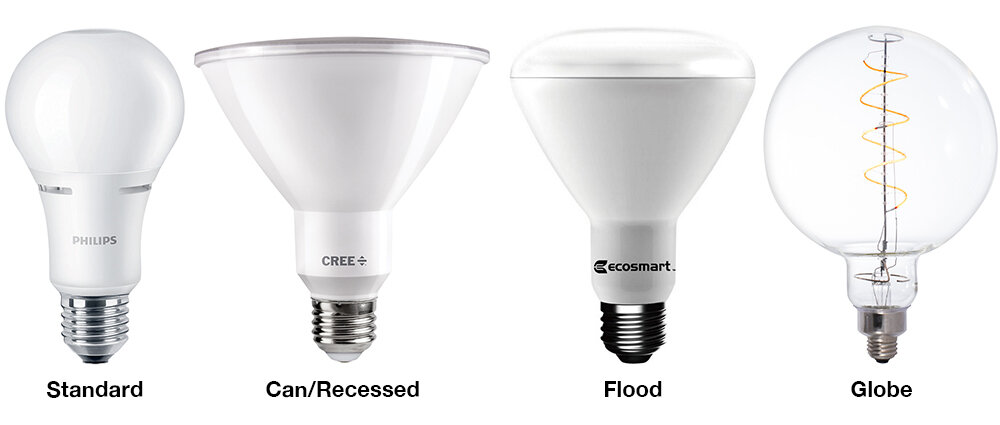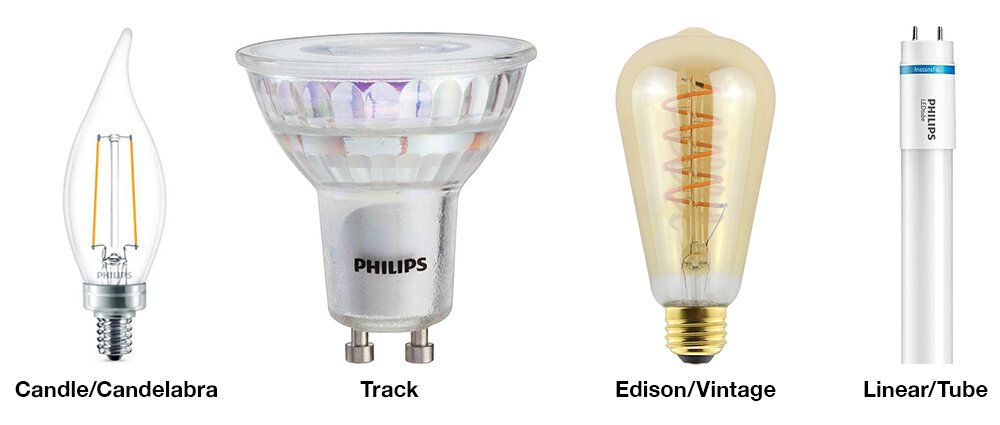Types of LED Lights
LED lighting is an energy-saving alternative to traditional incandescent bulbs. LED light bulbs can be used as replacement bulbs in most common light fixtures, including accent lighting, lamps, track lighting and even outdoor flood lights. Some types of LED lights are self-contained fixtures with no bulbs to replace. This guide outlines the features and benefits of various types of LED lights so you can find the best LED lights for your home.
What is LED Lighting?
“LED” stands for light-emitting diode, the technology behind LED lighting. When asking “what is LED lighting?” you usually want to know the difference between LED bulbs and traditional incandescent bulbs.
Incandescent bulbs have a thin metal filament that heats up as electricity passes through it. When heated enough, the filament glows to produce light.
An LED light works by having an electrical current pass through a semiconducting material – the diode. The tiny diodes within an LED bulb cast light when electricity is applied. This technology doesn’t rely on heat to produce light and has greater energy-efficiency than incandescent bulbs.
To light up a room, an incandescent lamp might use 60-watts of electricity, while an LED bulb will produce the same amount of light using about 10-watts.
Energy efficiency is one of the most important LED light advantages, but low maintenance is another great benefit. LEDs have an exceptionally long lifespan of more than 10 years because there is no filament to burn out. As manufacturers work to refine the production process, the upfront costs of LED lighting have come down, contributing to long-term savings.
Another benefit is that LEDs emit almost no heat or UV rays. They are usually not hot to the touch, making them safer to handle than incandescent bulbs. Plus, they can help reduce air conditioning costs and won’t cause nearby fabrics and furniture to fade.
LED lighting comes in many shapes, sizes, colors and temperatures for use throughout the home.
Types of General Purpose Bulbs
Standard LED light bulbs: Standard LED bulbs disperse light at a wide angle throughout a room. They’re ideal for reading lamps, hallways and other common fixtures such as semi-flush and flush-mount fixtures.
Can LED light bulbs: Also known as recessed lights, can light LED bulbs fit into sockets – or cans – mounted in the ceiling.
Flood LED light bulbs: Flood bulbs are designed to emit a strong but wide beam of light to illuminate a broad area. They’re mainly used in exterior applications.
Globe LED light bulbs: Globe bulbs emit light in every direction, making them ideal for bathroom vanities and pendant lights.
Types of Decorative Bulbs
Candelabra LED light bulbs: Candelabra bulbs, also known as candle bulbs or chandelier bulbs, emulate the shape of a candle flame. They work best in accent lighting, wall sconces and decorative fixtures.
Track LED light bulbs: Track lights are often used for directional lighting, work area task lighting or to highlight something specific such as artwork and other decorative features.
Edison LED light bulbs: Edison bulbs, or vintage bulbs, are all about aesthetics and ambience. These are best suited for decorative fixtures like pendant lights and industrial chandeliers.
Tube LED light bulbs: Tube lights, also known as linear light bulbs, have a functional style designed for more professional applications like office buildings, kitchens and workspaces.
Other LED Light Options and Features
LED lights are not limited to replacement bulbs. Some fixtures, including certain models of ceiling fans and recessed downlights, have integrated LED lighting.
LED technology is also found in some flexible light strips or tape that can be used as under-cabinet lights. This can be used to add task lighting in the kitchen or to provide ambiance and decorative accents in other living spaces.
Holiday lighting can be replaced with LED Christmas string lights that will reduce energy consumption. LED string lights also pose less of a fire hazard because LED lights emit only small amounts of heat.
Some types of LED lights are dimmable. Be sure to check packaging to determine if the bulb is compatible with dimmer switches.
Look for ENERGY STAR-certified LED bulbs, which have been tested for color quality, light output and efficiency.
Smart LED bulbs connect to a Wi-Fi network to allow remote control of the lights. Features such as dimming and color-temperature tuning are available. Some models don’t require a smart-home hub for operation.
How to Choose a Bulb Based on Color Temperature
Soft white LED bulbs provide a warm, comfortable light that is good for cozy spaces like bedrooms and living rooms.
Bright white LED bulbs have a cool and refreshing light that is best used in kitchens, bathrooms or garages
Daylight LED bulbs emit light to mimic energizing daylight. They’re good for reading or intricate projects and can be used in bathrooms, kitchens or basements.
LED Brightness
The brightness of all types of LED lights is measured in lumens. More lumens means a brighter bulb.
Traditional incandescent bulb brightness is measures in watts. Because LEDs use far less energy than incandescents, a better way to gauge the brightness of LED bulbs is to compare lumens.
For example, a traditional 60-watt light bulb will emit around 700-lumens. An LED bulb with comparable lumens uses less than 10-watts of electricity.
Lumens = the amount of light the bulb gives off
Wattage = the amount of energy a bulb uses
To choose the most energy-efficient light bulb and not sacrifice brightness, check the lumens per watt ratio on the bulb’s packaging. The greater the lumens-to-watts ratio a bulb has, the more energy-efficient it is.





